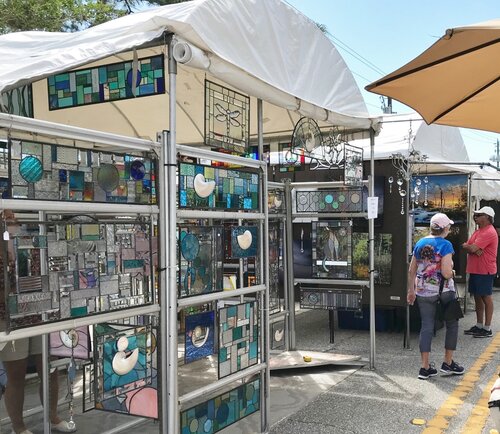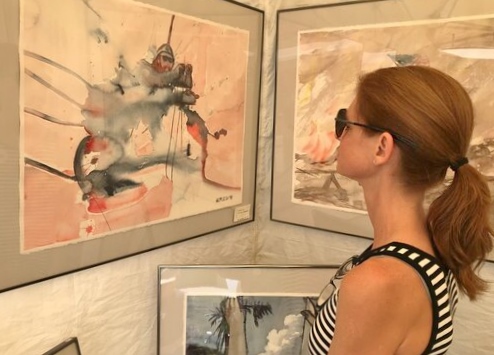by Carolyn Edlund
There are many benefits of selling your artwork at live shows and festivals.

Outdoor art and craft festival in Englewood, Florida
This traditional way of selling art and handmade items has been popular for many years. It offers an opportunity to connect directly with the public. There is no substitute for meeting face-to-face, and interacting with crowds at art fairs and festivals gives you that chance. Buyers view the art in person and can understand it most fully.
Fairs are often an initial contact point where collectors become intrigued by your work. It’s likely that most booth visitors will not buy. But by obtaining contact information, you can build a list of prospects and reach out again and again. The vast majority of sales are made after numerous contacts happen. This is why it’s essential to get names on your list and follow up.
It may be that the sales you close from these prospects eventually happen in other ways. Fans who meet you at a festival may be driven to your website, a brick and mortar gallery or other retailer that represents you. Or, local fans may even be directed to your studio where they can stop in and buy a piece of your art. Artists who begin a friendly personal relationship with customers are building a network of connections that can turn into repeat collectors, and also provide referrals.
Another benefit of fairs and festivals is getting feedback. Speak with visitors to your booth, making a point to listen to them and gather information. What do they like? What objections do they have to making a purchase? Learn who is interested in your work so you can develop a clear customer profile and understand your best prospects. You can learn a lot from conversations, and consequently display and sell your work more effectively going forward.

A customer shops in an artist’s booth
Select the right event
Which events are best for you? The answer to this question is different for each individual artist. Overall, juried fairs are preferable because they will ensure a higher quality of exhibitor and customer. Sites like Art Fair Calendar list upcoming shows in many local areas with application links and deadlines.
Then, check a site like Art Fair Insiders for reviews written by other artists to get the inside scoop. Social media discussion groups and online forums can offer assistance. Exhibitor reviews will help you understand the type of fairgoer who attends, how management treats the artists and resolves issues, and whether sales are brisk.
Fairs have life spans. Some will be on the rise, increasing their reputation, attendance and quality of art, while others are in decline. It’s good to know the lay of the land before you apply to exhibit.
Although written reviews can be helpful, its always best to walk a show before applying if possible. See for yourself the mix of other art for sale, the amount of buying going on, and whether your target customer seems to be in attendance.
Prepare your submission
When you apply to a show, be ready to submit excellent photographs of your art or craft. Top shows are incredibly competitive. In your application, describe your art accurately for the jurors who will be selecting artists. Make sure the images of your art are taken as professionally as possible. Your competition is already doing that. And don’t forget that you will need a booth shot as well.
Plan your display
At a fair, your booth may be located inside or outside, and you as the artist must be prepared for the requirements of that space. Indoor shows mean that you need plenty of excellent lighting for your booth. With outdoor shows, it’s standard to have a tent to enclose your display and protect it from the elements. Either way, merchandising is crucial. Making your booth look like a gallery will give it an upscale look. Avoid overcrowding items on display, which gives a confusing presentation and tends to give the impression that your art is of lower value. Use different levels to lead the eye, and add interest to your display.
Thousands of artists travel the show circuit every year. It can be a full-time business for some, but for others is one of several streams of income that helps run their businesses. Retailing at shows and fairs can be challenging, with seasonal changes making it difficult to show year-round unless you are willing to travel to cooler and warmer climates as fair schedules dictate.
Retailing to the public at fairs and festivals drives sales and cash flow. It also takes you out of the studio, which means you must balance your schedule carefully in order to produce, sell your work, and have enough time for a personal life.


Speak Your Mind